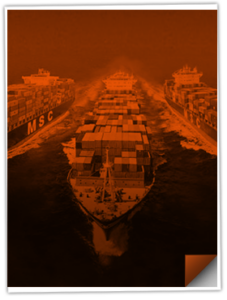Featured Headlines:
Liberation Day from Liberation Day?
Shippers Playing Warehouse Whack-a-Mole
U.S. and China Agree to a TARIFF-ying Pause
CBP’s March Metrics Bring the Heat
India–Pakistan Tensions Jam Up Global Cargo Routes
Track to the Future… Derailed?
Speed Limits, ELDs, and Eye Rolls: Truckers Weigh in on Deregulation
Liberation Day from Liberation Day?
- Today, we bring you some alternative “holiday” names after the U.S. and China agreed to a 115% slash in reciprocal tariffs, igniting an instantaneous, tumultuous front-loaded peak season on the transpacific eastbound trade:
- Devastation Day or Immolation Day. This is the correct name for April 2.
- Celebration Day. Importers from China are back in business, baby!
- Desperation Day. With a 90-day grace period on reduced tariffs, U.S. retailers are rushing to restock before any new trade policy storm rolls in.
- Degradation Day. Ahhh, now we see the great harm that April and May’s blank sailings have done. Where is the capacity and reliable service?!
- Deprivation Day. Our ocean carrier partners want you to part with your money, folks. GRIs of $3000; PSSs of $2000; FAK rates of $8000 on June 1?
- Emulation Day. It sure ‘nuff is interesting how similar the GRI and PSS notices are for ALL major carriers. Must be a coincidence!
- Compensation Day. After crushing it for all of 2024, the ocean carriers are set-up perfectly for record profits again.
- Animation Day. Hey, at least newsletters, the JOC, and the network news are interesting and spicy again.
- Interrogation Day. “Hey Shapiro, if I shipped goods from three different countries in one container and entered that in a bonded warehouse, should I enter everything into consumption, pray for rain, or enhance my bond?” Look, customers, we love you… we know this stuff is important!
- Calculation Day. Will the grace period end with SAIL dates on August 14th or arrival dates or entry dates? What is the risk of negotiations going badly “south” before the dog days of August?
- Depravation Day. At what point do we question the ethics and morals of manipulating overall supply only to absolutely crush shippers with tremendous freight increases?! How is this fair?
Thanks, but No Thanks!
- Hoping to lure carriers back from their scenic (yet dangerous!) detour around the Cape of Good Hope, the Suez Canal Authority (SCA) is dangling a 15% discount on container transits starting May 14th. It comes with an action photo too!
- You know things are rough when the SCA is basically sending “U up?” texts to the ocean freight world. And, for ocean carriers, the Suez wields a double-edged sword… much of 2024’s success was connected to effective capacity reduction… and slicing the flesh directly off of shippers with that sharp sword, of course!
- The SCA cited “positive developments in the security situation” in the Red Sea and Bab al-Mandab Strait. Translation: “Please come back, we’re slightly less deadly now! Really!”
- The rebate applies to vessels with 130,000+ net tons, for both northbound and southbound transits, and lasts 90 days—because nothing says “confidence in the long-term” like a limited-time coupon.
- The debate applies to the value of a limited Houthi ceasefire with the US. After all, the Houthis maintained the “right” to attack Israeli assets and cargo. Do we think the Houthis hold the AMS filings for every vessel in sight? Well, do we?!
- In 2024, Houthi attacks rerouted ships, and the Suez has lost two-thirds of its container traffic and about $6 billion a year. Ouch, Egypt!
- A French giant may be first to jump back in… no, NOT Andre the Giant (and we bet you didn’t know he was French!) CMA CGM already met with the SCA and reportedly called the canal “the shortest and fastest route”. Even giants state the obvious, it seems!
- Meanwhile, President Trump claimed the Houthis have surrendered. Most carriers responded by… continuing to avoid the canal. So yes, business as usual.
- In honor of Andre’s role in The Princess Bride, we shall end with this quote: “It just so happens that your canal friend here is only mostly dead. There’s a big difference between mostly dead and all dead.” May the Suez prosper again, folks!
Shippers Playing Warehouse Whack-a-Mole
- Bonded warehouses are the new VIP clubs. Everyone wants in, but nobody can find one; and some importers are now eyeing Canada like it’s a Costco with no lines.
- Importers are racing the tariff clock, cramming ports with goods that weren’t meant to land yet.
- Prologis reports warehouse utilization jumping past 90% as shippers beg for anything with four walls and a loading dock.
- Turns out that overflow space is the new black.
- Loads out of L.A. are up 17%, and Phoenix is hotter than ever with a 52% spike. Last week was DAT’s busiest ever, beating even the 2021 pandemic surge. Yes, that one.
- Despite the chaos, there’s so much truck capacity out there it’s practically waving from the side of the road.
- Flexible inventory positioning is the buzzword of the moment. But for shippers, it translates to: “Please find me a legal spot to stash my tariff-dodging goods yesterday.”
- When your freight is playing musical chairs across the country, somebody’s going to end up standing. Probably near a port. With a clipboard.
U.S. and China Agree to a TARIFF-ying Pause
- On Monday, the White House and China released a joint statement from Geneva outlining a 90-day tariff pause with the following to take effect no later than May 14th:
- The additional ad valorem duties imposed on China in April will be suspended for 90 days following an agreement reached with China. The 20% “fentanyl” tariffs and the 10% base reciprocal tariffs remain in effect for Chinese imports into the U.S. resulting in a current total of 30% in duties (plus whatever standard or baseline tariff applies to a given product).
- China has also agreed to roll back their additional ad valorem duties resulting in 10% tariffs on U.S. imports into China.
- Notably, the current tariff suspension does not include any provisions around de minimis imports into the U.S. The provision continues to be suspended at this point in time. Reduced to 54% + $100 flat (not increasing to $200 in June)! But wait…
- Then, on Tuesday, the White House issued further guidance on the reduction in Chinese Tariffs. Below is a summary of the key changes, effective May 14, 2025:
- There will be a 90-Day Suspension of Higher Ad Valorem Rates:
- The U.S. is suspending a portion of the additional ad valorem duties previously imposed under Executive Order 14257. For the next 90 days, covered Chinese-origin goods (including those from Hong Kong and Macau) will be subject to a reduced 10% additional ad valorem duty, down from 34%.
- What does “effective May 14, 2025” mean?
- We finally have an answer! The effective date is the entry date of the cargo.
- “Effective with respect to goods entered for consumption, or withdrawn from warehouse for consumption, on or after 12:01 a.m. ET on May 14, all articles imported into the customs territory of the U.S. from China, including Hong Kong and Macau, shall be, consistent with law, subject to an additional ad valorem rate of duty of 10% subject to all applicable exceptions set forth in Executive Order 14257 and the Presidential Memorandum of April 11, 2025.”
- De Minimis Threshold Adjustments:
- In parallel, duty rates on low-value imports (such as postal shipments) will be lowered.
- The ad valorem rate drops from 120% to 54%.
- The current $100 per postal item duty will remain in place but will not increase to $200 as originally planned on June 1st.
- There will be a 90-Day Suspension of Higher Ad Valorem Rates:
- Learn more about these actions in our Tariff News section: Trump’s Trade Tariff Updates
CBP’s March Metrics Bring the Heat
- If your import operations felt a little more scrutinized in March, it wasn’t just your imagination. U.S. Customs and Border Protection (CBP) has released its monthly stats, and enforcement activity jumped sharply in several key areas.
- Compared to February 2025, in March:
- Entry summaries topped 3 million, up 11.1%, representing over $352 billion in goods (a 16.2% increase).
- Estimated duties collected hit nearly $15 billion—that’s a massive 97.4% jump over February.
- On the enforcement front:
- Forced labor enforcement saw a dip: 434 shipments were flagged (down 57.6%) with a value of just over $2.3 million (a 76.4% drop).
- Counterfeit seizures crept up, with 1,827 shipments stopped (up 0.7%), but their total value skyrocketed, more than $913 million, marking a 73.9% increase.
- Import audits were the big shocker: 71 audits wrapped in March (a 153.6% increase), with duties and fees assessed at over $310 million. That’s not a typo: 10,589% higher than February.
- CBP’s latest numbers make one thing clear: enforcement intensity is on the rise— especially around revenue recovery and trade fraud.
- Want to dive into the full report? You can check it out here: CBP March 2025 Monthly Update
Surgin’ General Warning
- To best describe the coming tidal wave, let’s look at the recent past:
- The average global container rate hit $2076/40’; the lowest average since 2023.
- Asia to US container rates declined to below $2000 WC and below $3000 EC.
- An estimated 1M containers of US cargo were paused in China. The minimum estimation is 1M TEUs!
- Transpacific blank sailing frequency eclipsed 30%. Many services became effectively fortnightly offerings (unheard of for this trade).
- Ocean carriers suspended several services entirely.
- Let’s breathe a moment and absorb the relative position of the market on May 12th.
- Along came a trade deal (in case you haven’t heard!). Tsunami City! What we see on May 15, 2025:
- Bookings from China doubled within hours yesterday.
- The ocean carriers quickly practiced their speeches about the “dislocation of assets”, the deployment of vessels in other trades, and the lack of space. They simply HAD to blank all that capacity to remain solvent and stuff. No, they did!
- “Hey shippers, it could take us six weeks to get our vessels back in action!”
- Service contracts were instantly treated like the drunken, “political,” obscene uncle at the wedding or Thanksgiving. “Do we even know you?!”
- Look out below! Pundits are already fretting about container shortages, port congestion, and locusts at origin! If blanking blanks don’t go out, they don’t come home with all those yummy, shiny empty containers!
- PSSs announced for June 1 became PSSs announced for May 21. Heyyyy, didn’t we see “outlandish” GRI and PSS notices on April 15th? Is this anything like our Senators and Representatives and their timely stock market bets?!
- What about extra loaders? What about extra loaders??!! Crickets.
- It’s the same old story, same old song and dance, my friend. Thanks, Steven Tyler.
- While the duty reprieve is huge, here are a couple of sobering stats to consider:
- Greater than 60% of America’s 30 million small businesses have less than a two-month cash reserve. For importers from China, this is bleak.
- Even after the large reductions, the average duty for imports from China is 40%… by historical standards, this is a giant number. 30% + an avg “regular” duty of 10%.
- For all origins, the average import duty to the US is now up to 17.8%, the highest since 1934. For you zany math wizzes, that is but five years from 1929.
- Let us end by fact-checking our tsunami metaphor: tidal waves can travel 500mph (jet speed), cross the Pacific in a day, average 100 feet high—though the record is 1720 feet (!)—and are considered the most-costly natural disaster on our planet by the World Bank.
- Yeah, the metaphor is perfect, sorry to say!
India–Pakistan Tensions Jam Up Global Cargo Routes
- After a deadly attack in Kashmir, India and Pakistan have closed their skies to each other’s aircraft until at least May 23.
- Indian carriers are burning time and jet fuel as they detour around Pakistan—adding up to 90 extra minutes per flight. What’s that cost? Oh, just a cool $36.7 million a month, mostly in fuel and crew.
- With $4.2B in Q1 pharma exports, India can’t afford compromised temperature control. Time-sensitive shipments are sweating—literally—and forwarders are rethinking route viability.
- IndiGo taps out. The airline is already suspending flights to Almaty and Tashkent, killing off critical belly cargo space. Belly up, indeed.
- Freighter aircraft are having to choose between fuel and freight—not a great place to be when you’re already maxed on takeoff weight.
- The last India–Pakistan airspace spat lasted two weeks. This time, the fuel prices are higher, fleets are tighter, and nobody has the patience for déjà vu.
- The closure could trigger reviews of bilateral aviation agreements, force new NOTAMs, and squeeze ATC corridors through Iran and Central Asia.
- Winners? DHL, FedEx, UPS. Integrators smell opportunity as shippers look for reliability over price. Premium service just got a little more… premium.
Track to the Future… Derailed?
- Norfolk Southern (NS) is pulling the brakes on over 20 international intermodal routes, including Port of Virginia to Memphis and Chicago to Jacksonville, citing weak container volumes.
- The changes, effective May 31, reflect a shift in focus: NS says it’s reallocating resources to support higher-growth lanes—but don’t call it a breakup; they say they’re still committed to international trade (just… selectively).
- One of the biggest cuts? Virginia to Memphis, a route launched with high hopes in 2023 that turned out to be more fizzle than freight (or sizzle than steak in Australia!). Carriers and shippers stuck with more active options via Charleston and Savannah.
- Chicago to Jacksonville also gets cut, dealing a blow to shippers moving freight onward to Puerto Rico via Jones Act carriers like Crowley, TOTE, and Trailer Bridge.
- NS stressed it will maintain domestic service on key corridors (like Chicago–Jacksonville), but international boxes will need local drayage hookups or a switch to CSX, which remains in the game for Puerto Rico cargo.
- NS also plans to convert its Norfolk Portlock Yard into a domestic-only hub, nudging any remaining international cargo back to on-dock handling at the Port of Virginia.
Speed Limits, ELDs, and Eye Rolls: Truckers Weigh in on Deregulation
- DOT inbox = chaos. Nearly 900 comments rolled in after the Department of Transportation (DOT) asked the industry where it should cut red tape.
- Top of the hit list? Speed limiters, mandatory automatic emergency braking (AEB), electronic logging devices (ELDs), and those ever-controversial hours of service (HOS) rules. Basically, everything that beeps, blinks, or slows a rig down.
- The ELD rebellion continues. Drivers want to ditch digital logs and return to paper.
- But it’s not all deregulate-this, deregulate-that. Some groups, like the National Association of Small Trucking Companies (NASTC), say it’s time to crack down on freight fraud—calling for a full-time DOT task force to chase down shady operators and protect legit carriers.
- Also on the wishlist? A more active fraud complaint database, better enforcement coordination, and some serious Justice Department muscle.
- Whether it’s speed caps or scam prevention, the Trump administration is now holding the wheel—and the industry’s got a long list of detours it wants to take.



